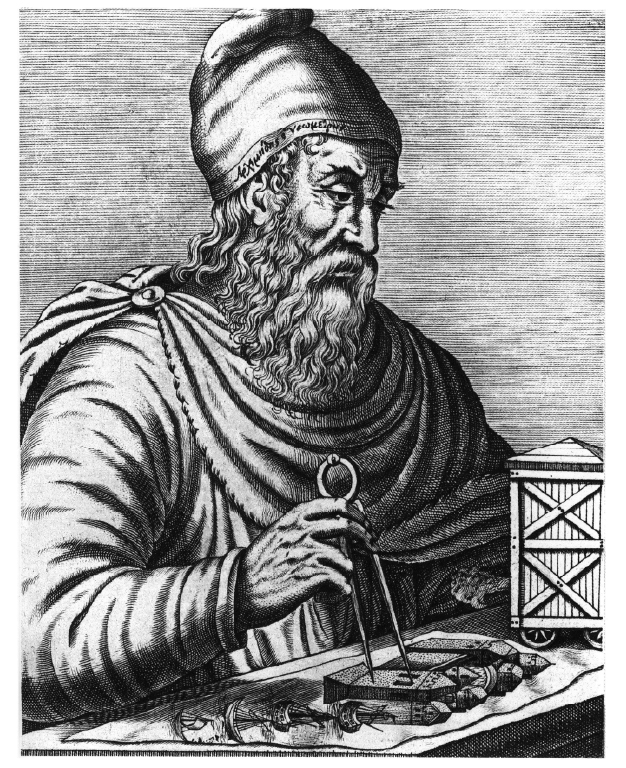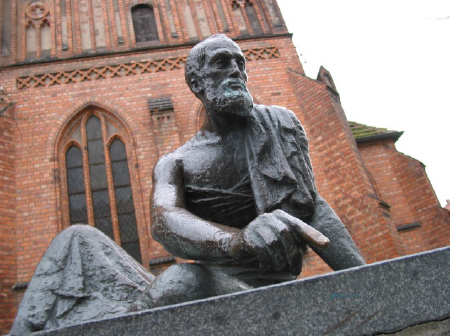Science is all about facts and discoveries, with some of the remarkable breakthroughs coming from seemingly everyday occurrences and experiences. One of the oldest and well-known tale revolves around Archimedes' legendary “Eureka!” moment while taking a bath in a tub, when he made a remarkable discovery, what is now known as the Archimedes Principle. Supposedly, Archimedes was so thrilled and excited with this discovery that he immediately hopped out of the bath and ran onto the streets to tell the king, shouting loudly 'Eureka! Eureka!' (I have found it! I have found it!), in delight. Archimedes went on to make a number of important contributions in science and mathematics. He was the first to realize that the number Pi features in the formula for the circumference of the circle, the area of the circle, and the volume and area of the sphere (notably, he determined an accurate estimation of the value of Pi).
 Here’s a closer look into this sudden discovery (the “Eureka!” moment): The famous Greek mathematician, physicist, and astronomer, Archimedes was born in 287 BC in Syracuse, a Greek colony in Sicily (an island now part of Italy). He died in 212 BC when the Romans invaded Syracuse. Archimedes is still regarded as one of the greatest scientists of all time. Archimedes's tale takes place some 2,250 years ago. After gaining the royal power, King Hieron II of Syracuse in Sicily gave a goldsmith a bar of gold to make it into a crown. After goldsmith delivered the pure gold crown to the king, he was suspicious. The king suspected that the goldsmith had cheated him. The king thought the goldsmith had mixed some of the gold for the cheaper silver, while keeping the leftover gold. However, the king had no way of proving his suspicions, so he asked Archimedes to find out whether the crown was made from pure gold, without damaging the crown. He told the king he would need a few days to think about it. One day, while he was concentrating about this problem, he decided to take a bath in a tub full of water. He immediately noticed that the water splashed out of his bath tub onto the floor the moment he stepped into it, and the more he stepped into the tub, even more water got displaced out of the tub. He realized that he had made a real mess. But that mess triggered an idea that would help solve the king’s dilemma. “When I got into the tub,” Archimedes reasoned, “my body displaced a lot of water. Now, there must be a relationship between my volume and the volume of water that my body displaced—because if I weren’t so big, less water would have spilled on my floor.”
Here’s a closer look into this sudden discovery (the “Eureka!” moment): The famous Greek mathematician, physicist, and astronomer, Archimedes was born in 287 BC in Syracuse, a Greek colony in Sicily (an island now part of Italy). He died in 212 BC when the Romans invaded Syracuse. Archimedes is still regarded as one of the greatest scientists of all time. Archimedes's tale takes place some 2,250 years ago. After gaining the royal power, King Hieron II of Syracuse in Sicily gave a goldsmith a bar of gold to make it into a crown. After goldsmith delivered the pure gold crown to the king, he was suspicious. The king suspected that the goldsmith had cheated him. The king thought the goldsmith had mixed some of the gold for the cheaper silver, while keeping the leftover gold. However, the king had no way of proving his suspicions, so he asked Archimedes to find out whether the crown was made from pure gold, without damaging the crown. He told the king he would need a few days to think about it. One day, while he was concentrating about this problem, he decided to take a bath in a tub full of water. He immediately noticed that the water splashed out of his bath tub onto the floor the moment he stepped into it, and the more he stepped into the tub, even more water got displaced out of the tub. He realized that he had made a real mess. But that mess triggered an idea that would help solve the king’s dilemma. “When I got into the tub,” Archimedes reasoned, “my body displaced a lot of water. Now, there must be a relationship between my volume and the volume of water that my body displaced—because if I weren’t so big, less water would have spilled on my floor.”
 Archimedes questioned- what if he put the crown in water? How much water would it displace? And could he apply this to prove that the crown was made of pure gold? He realized that the crown’s density was the key. Archimedes already knew that gold was denser than silver. He first took a piece of gold and a piece of silver with exactly the same mass. He dropped the gold into a bowl filled to the brim with water and measured the volume of water that spilled out. Then he did the same thing with the piece of silver. Although both metals had the same mass, the silver had a larger volume; therefore, it displaced more water than did the gold. That’s because the silver was less dense than gold. So he realized that if a certain amount of silver had been substituted for the same amount of gold, the crown would occupy a larger space compared to an identical amount of pure gold. He then reasoned that if the goldsmith had had indeed made a crown of pure gold, then the volume displaced should be the same as that of a bar of pure gold of the same mass.
See an animation here.
Archimedes questioned- what if he put the crown in water? How much water would it displace? And could he apply this to prove that the crown was made of pure gold? He realized that the crown’s density was the key. Archimedes already knew that gold was denser than silver. He first took a piece of gold and a piece of silver with exactly the same mass. He dropped the gold into a bowl filled to the brim with water and measured the volume of water that spilled out. Then he did the same thing with the piece of silver. Although both metals had the same mass, the silver had a larger volume; therefore, it displaced more water than did the gold. That’s because the silver was less dense than gold. So he realized that if a certain amount of silver had been substituted for the same amount of gold, the crown would occupy a larger space compared to an identical amount of pure gold. He then reasoned that if the goldsmith had had indeed made a crown of pure gold, then the volume displaced should be the same as that of a bar of pure gold of the same mass.
See an animation here.
Now it was time to check out the crown. To find out the crown’s volume, Archimedes immersed the crown in a bucket filled with water to the brim, and measured the volume of the spilled water. Then he took a bar of pure gold of the same mass and compared the volume of spilled water to determine if crown is indeed made of pure gold. Surprise, surprise – the numbers were different! The crown displaced more water than the piece of gold. Therefore, the crown’s density was less than pure gold. So, indeed the king had been cheated by the goldsmith. You can probably guess as to what happened to the goldsmith!
 Archimedes wrote about this experiment in his book, On Floating Bodies. The famous 17th century astronomer and physicist, Galileo Galilei was a big admirer of Archimedes. Galileo once wrote “…to those who have read and understood the very subtle inventions of this divine man in his own writings; from which one most clearly realizes how inferior all other minds are to Archimedes’…” In fact, in the 1600s (17th century A.D.), Galileo verified Archimedes’ finding (the Eureka! moment) with precision, using his own, a slightly different method, where he balanced a crown made of “impure gold” on a scale against a bar of pure gold in air, and then the scale is submerged with crown and gold in water to see if they still balance. In Galileo's plan, if the crown was made of pure gold, the buoyant forces on the crown and the gold bars would be the same and the balance would remain horizontal. This would happen because Archimedes's principle states that the same weight of the same substance must occupy the same volume, whatever the shape. If the crown was impure, it would have a slightly larger volume than one of pure gold (remember, since silver is less dense than gold, it takes up more space than the equivalent weight of gold). Immersed in water, a larger-volume crown would be buoyed more than the matching gold bar; this would cause the balance to tip, with the crown side higher than the side containing the pure gold bar.
Archimedes wrote about this experiment in his book, On Floating Bodies. The famous 17th century astronomer and physicist, Galileo Galilei was a big admirer of Archimedes. Galileo once wrote “…to those who have read and understood the very subtle inventions of this divine man in his own writings; from which one most clearly realizes how inferior all other minds are to Archimedes’…” In fact, in the 1600s (17th century A.D.), Galileo verified Archimedes’ finding (the Eureka! moment) with precision, using his own, a slightly different method, where he balanced a crown made of “impure gold” on a scale against a bar of pure gold in air, and then the scale is submerged with crown and gold in water to see if they still balance. In Galileo's plan, if the crown was made of pure gold, the buoyant forces on the crown and the gold bars would be the same and the balance would remain horizontal. This would happen because Archimedes's principle states that the same weight of the same substance must occupy the same volume, whatever the shape. If the crown was impure, it would have a slightly larger volume than one of pure gold (remember, since silver is less dense than gold, it takes up more space than the equivalent weight of gold). Immersed in water, a larger-volume crown would be buoyed more than the matching gold bar; this would cause the balance to tip, with the crown side higher than the side containing the pure gold bar.
In Physics, this Archimedes' Eureka moment is called the Archimedes Principle, which states that when a body is immersed in a liquid, it experiences an upward buoyant force, which is equal to the weight of the liquid displaced by the body. In fact, buoyancy explains why some objects float, and others don't. For example, a ball of steel, will sink because it's unable to displace water that equals its weight. But steel of the same weight but shaped as a bowl will float because the weight gets distributed over a larger area and the steel displaces water equal to its weight. This is how large ships that weigh several thousand tons float in the ocean.
For more details and to conduct a demonstration experiment to verify the Archimedes Principle, contact Dr. Akhtar Mahmood (amahmood@bellarmine.edu). By the way, whenever you have a great idea or managed to solve a hard physics or a math problem, you may run up and down the hallway of Siena Quarto and shout “Eureka! Eureka!” as loud as you can.